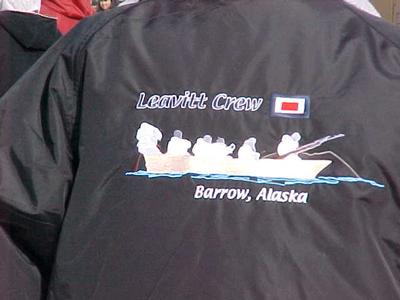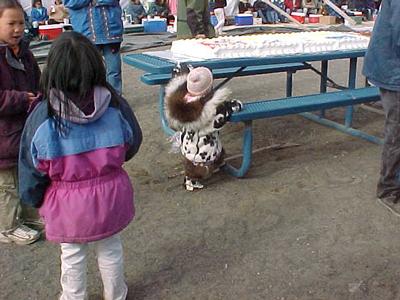29 June, 2001
Friday
Another "Nalukataq" was held this evening. This time there were 4 crews
celebrating together so the number of people was much larger. A local
woman took us under her wing and served us tea and directed us on how to
get some better pieces of whale meat. We followed her advice and ended up
with a 4-inch by 4-inch chunk of frozen meat, which we all sampled, twice
is just not enough to develop a taste for the delicacy. The Inupiat
culture revolves around hunting be it for whale, seal, walrus or caribou.
The celebrations help bring the community together and provide a time to
share with one another. Historically money did not have a role here.
Barter was the economic backbone of the community. Everyone worked and
had a role in providing for the community. If you didn't hunt you
prepared food or you made clothes from the skins. Life was hard and
everyone had to work together to survive.
This afternoon we went to the field and took freeze/thaw data along with
soil moisture measurements. This year the tundra has been dryer than in
past years. Glen is seeing differences in his plots as a result of the
soil moisture too.
We measure soil moisture with the instrument pictured below. On the
bottom there are 5 prongs that you insert into the ground being careful
not to compact the soil. The instrument does all the calculations for you
and the screen displays the percentage of water. We take 3 readings at
each site then average them. Back at the lab the instrument is plugged
into the computer and the data downloaded directly into a file on the hard
drive.
Soil moisture is an important part of studying gas exchanges here. The
soil moisture, soil temperature amount of respiration all have direct
effects on the CO2 being given off or being taken in by the vegetation
(flux).
The freeze /thaw measurements indicate the depth of soil (active layer)
which is available for the vegetation to grow into where roots are
undergoing gas exchanges. The greater the thaw depth the more potential
area for a CO2 source to exist. As you would expect thaw dept increases
over summer but if most of the climate change is to manifest itself in
warmer wintertime temperatures it is unknown how the fluxes would be
affected here.
Studying climate change and its effects involves taking and analyzing many
measurements that one does not automatically think about. It is my hope
you can see now how complicated and interconnected all the environmental
factors are which play a role, directly and indirectly in the bigger
picture. Warmer temperatures do not necessarily mean more plants (a CO2
sink) on a long-term scale.

This man is cutting the flukes for general distribution. Anyone can come up and take pieces of the meat from here. These sections are fermented and kept in the sun to give them a different flavor. In the background you see two of the four whaling crews at their seperate tables. Each crew distributes chunks of meat and cake to all the people present along with coffee and tea.

A closeup of one of the Leavitte whaling crew's jacket. Each crew has their name and flag on their jacket. They take great pride in the whaling crew they are a part of. For more information on Inupiat culture visit: http://nnlm.gov.pnr/ethnomed/inupiaq.html

The cake was the big attraction for this little one.
Contact the TEA in the field at
.
If you cannot connect through your browser, copy the
TEA's e-mail address in the "To:" line of
your favorite e-mail package.
|
